
| Sparshall's Moth (one synonym is Trichetra stibosoma, Butler, 1877) THAUMETOPOEINAE, NOTODONTIDAE, NOCTUOIDEA | (donherbisonevans@yahoo.com) and Mike & Pat Coupar and Stella Crossley |

(Photo: courtesy of Wendy Moore, Melbourne, Victoria)

| Sparshall's Moth (one synonym is Trichetra stibosoma, Butler, 1877) THAUMETOPOEINAE, NOTODONTIDAE, NOCTUOIDEA | (donherbisonevans@yahoo.com) and Mike & Pat Coupar and Stella Crossley |

(Photo: courtesy of Wendy Moore, Melbourne, Victoria)
These Caterpillars are gregarious when young, sometimes following each other like a freight train. Later instars become solitary, and rest conspicuously on the leaves of the foodplant during the day.
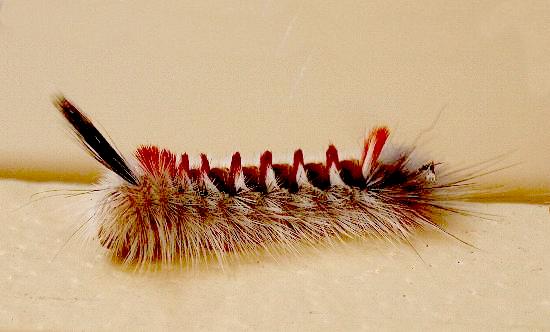
The caterpillars are hairy, often with a long tuft of dark hairs with white tips behind the head pointing forwards. There is a complex black saddle on the back of each abdominal segment, a conspicuous set of coloured tufts along the back, and many long pale lateral hairs.
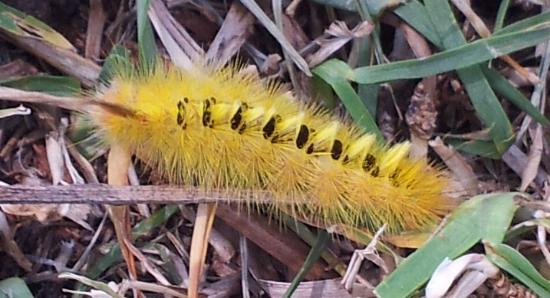
Over the last few years, we have had enquiries with photos that have
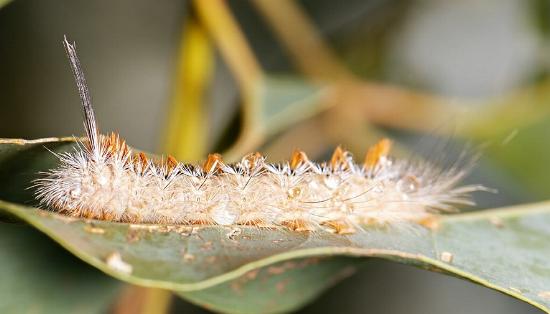
The DNA evidence suggests that there is only one species that occurs from the east to the west coasts of Australia. so it would seem that there are subspecies that each breed true to colour, in various parts of the country.
The caterpillars feed on various species of MYRTACEAE, including :
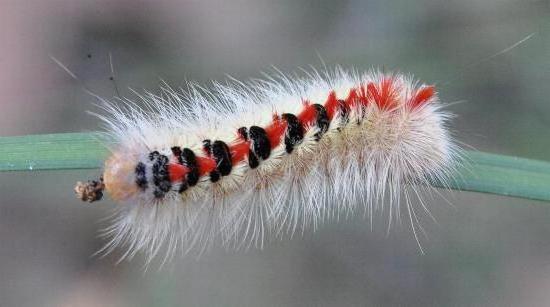
The heads are reddish, varying from pink to red. The lateral hairs seem to vary for the red tufted race between white and yellow. Perhaps some of the variations are sexual polymorphism, or other species of Trichiocercus. Many of these caterpillars are parasitised, and only rarely can be bred through to the adult moth.
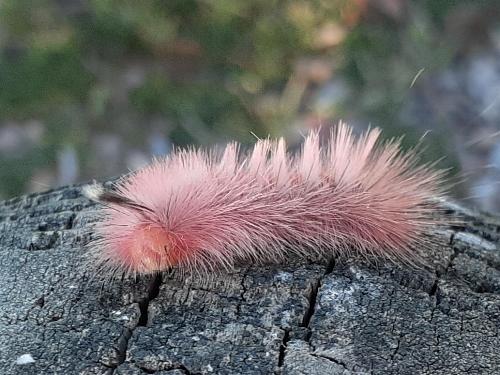
The caterpillars grow to a length of about 4 cms. The caterpillars pupate in a silk cocoon in ground debris.
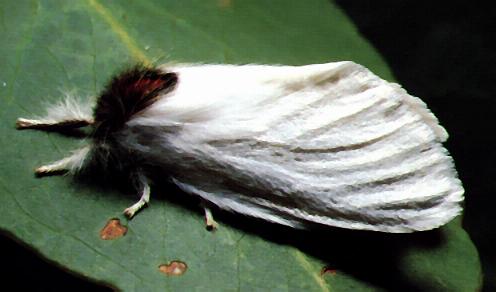
There is a range of wing shadings of the adult moths. Most are white, but specimens have be obtained from a light grey to a dark grey. Peter Marriott has reported seeing specimens from many places in Victoria from October to May, but there seems to be no time relationship between colour variations. Those from Mt. Martha on the Mornington Peninsula appear to be always white, but those from Ballarat and Kallista have the full range of shades.
The females have a head and thorax that are initially covered in black hair.
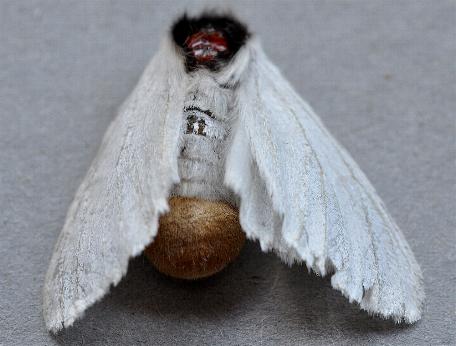
The females have narrow antennae, and a large tuft of short brown hair on the end of the abdomen, unlike the similar moth Trichiocercus mesomelas, which has black hairs around the tip of the abdomen.
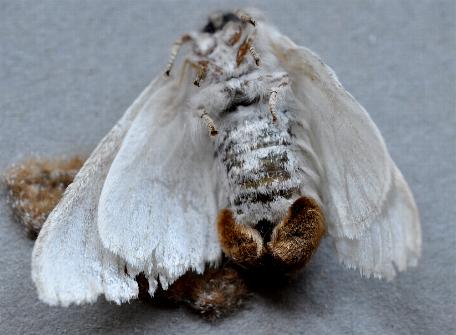
The males initially have white hair on the head and thorax, and have a large tuft of long pale brown hair on the end of the abdomen, and feathery antennae. The moths of both sexes rapidly lose hair off the thorax, revealing shiny brown skin. The moths of both sexes have a wingspan of about 4 cms.
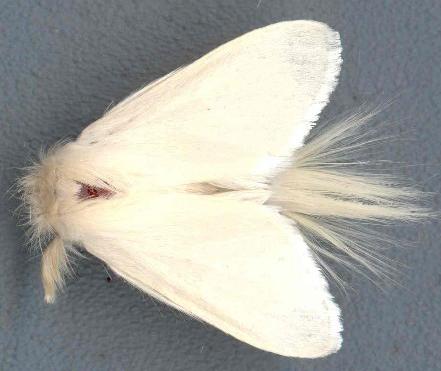
When disturbed, the moths curl up in a defensive posture, showing yellow bands along the body.
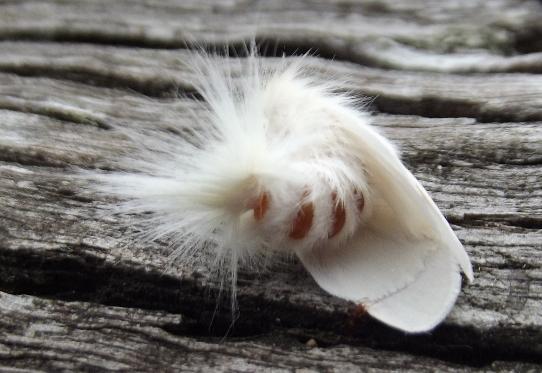
The species is found over most of Australia, including
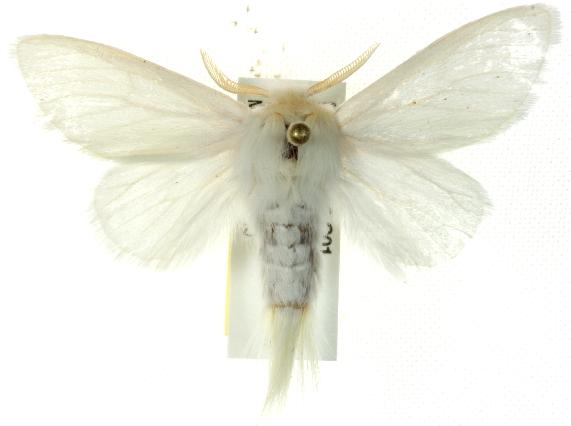
The eggs are spherical and pale green. They are laid in a array of 50 - 100, and covered in brown hairs from the tail of the female.

John Curtis first described the original specimen of this moth. Curtis said it was found by Joseph Sparshall :- "in a lane near Horning (Norfolk, U.K.), early in the morning of the 7th of August, 1829, ... resting on the trunk of an elm tree, he believes". This is the only record outside Australia of this species, and indeed its genus. Slightly puzzling.
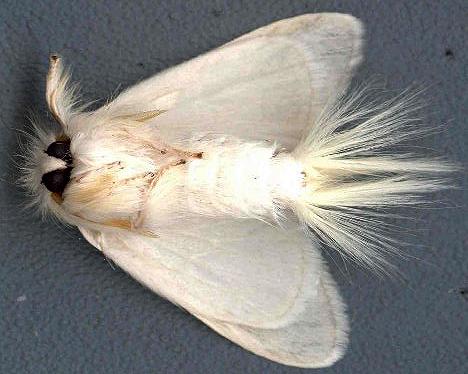
This species has been placed by various taxonomists in various other genera including Arcturus, Trichetra and Trichocercus. The species name has also been misspelled in the literature as sparshalii.
Further reading :
Ian F.B. Common,
Moths of Australia,
Melbourne University Press, 1990, fig. 54.13, pl. 30.8, p. 425.
Pat and Mike Coupar,
Flying Colours,
New South Wales University Press, Sydney 1992, p. 89.
John Curtis,
Illustrations and Descriptions of the Genera of Insecta found in Great Britain and Ireland: Containing coloured Figures from Nature of the Most Rare and Beautiful Species, and in Many Instances of the Plants Upon Which They are Found,
British Entomology,
Volume 5 (1830), Plate 336.
Peter B. McQuillan, Jan A. Forrest, David Keane, & Roger Grund,
Caterpillars, moths, and their plants of Southern Australia,
Butterfly Conservation South Australia Inc., Adelaide (2019), p. 147.
Peter Marriott,
Moths of Victoria: part 2,
Tiger Moths and their Allies - Noctuoidea (A),
Entomological Society of Victoria, 2009, pp. 8-11.
Buck Richardson,
Tropical Queensland Wildlife from Dusk to Dawn Science and Art,
LeapFrogOz, Kuranda, 2015, p. 180.
 caterpillar |  butterflies |  Lepidoptera |  moths |  caterpillar |
(updated 14 January 2013, 24 September 2022)